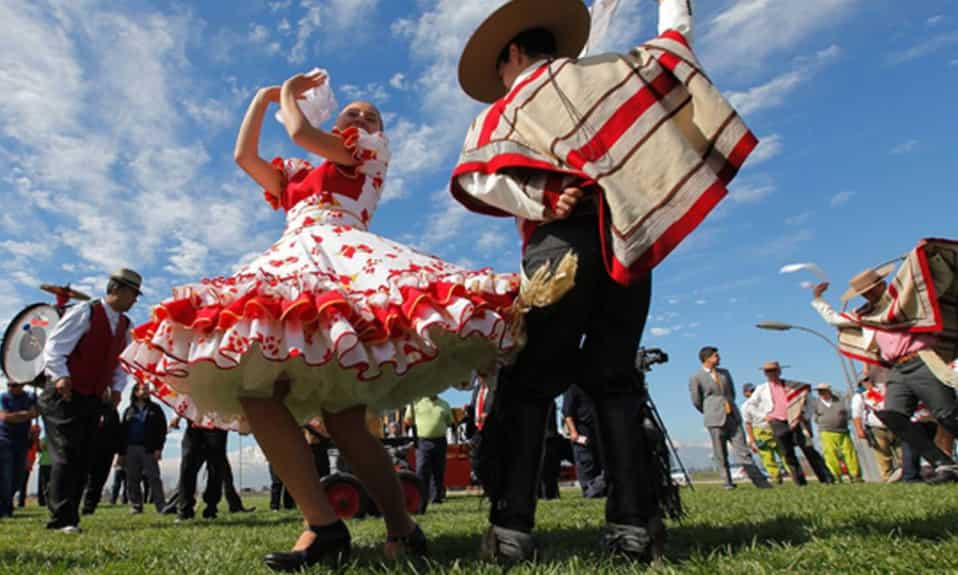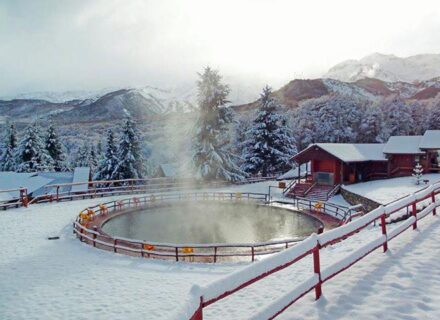If you are unfamiliar with the cueca, I recommend playing the songs “El Guatón Loyola,” written by Alejandro Gálvez, or “La Consentida” by Jaime Atria while reading this article. These melodies are instantly recognizable to most Chileans, especially during September when the country celebrates its Fiestas Patrias.
During this time, the cueca resonates throughout fairs, restaurants, plazas, and events nationwide. With just a white handkerchief (or even a napkin in a pinch), people begin to dance to its unique rhythm. This dance, characterized by turns, half-turns, and lively foot stomping, is an essential cultural symbol in Chile. In 1979, it was officially declared the national dance of Chile, and many believe its lyrics contain an unofficial history of the country.
However, the cueca is not exclusive to Chile. It is also present in other Latin American countries, including Bolivia, Peru, Argentina, and Mexico, where it is danced under different names and variations.
Characteristics of the Cueca
The cueca is traditionally performed in pairs, where the man takes on the role of conquest while the woman adopts a more elusive stance. The dancers trace circular patterns, incorporating turns and half-turns to the rhythm of a 6/8 or 3/4 time signature.
“The man pursues the woman, circling her. It is said to mimic the courtship of a rooster displaying its feathers to a hen,” Chilean musician Cuti Aste explained to BBC Mundo.
The fundamental instruments of the cueca include the guitar and the tambourine, although the accordion, piano, and bass are also commonly used.
There are various types of cueca. In Chile, the most well-known are the traditional cueca (or huasa), which is associated with rural culture and typically features dancers in traditional huaso or huasa attire, and the urban cueca, which emerged in the 1930s as a result of rural-to-urban migration.
Additional genres and subgenres of cueca exist, categorized by region, style, or theme. “If classified by region, we have the Chilotan cueca, Central cueca, or Northern cueca. If classified by style, we find romantic, political, or revolutionary cuecas,” ethnomusicologist and academic Christian Spencer noted.
Cuecas can be nationalist, leftist, peasant, romantic, heartbreak-themed, vengeful, or even fantastical. Despite their variations, all cuecas adhere to a fixed poetic structure. “The poetic form with its verses, syllables, seguidillas, and closing lines remains consistent, as does the rhythm,” historian Karen Donoso emphasized.
The Origins of the Cueca
The origins of the cueca are debated, with multiple theories suggesting different roots.
One theory attributes the cueca to African origins. Chilean historian Benjamín Vicuña Mackenna (1881-1886) claimed that the dance was introduced by enslaved Africans who passed through Quillota, Chile, en route to Peru during the colonial period. He proposed that its original name was “zambaclueca” and that Chileans later adapted it with their own cultural influences.
Another theory suggests an Arab-Andalusian influence, introduced by the Spanish during the conquest of the Americas. Others believe the cueca evolved from the dances of the indigenous Mapuche people.
A widely accepted theory, supported by 19th-century chronicler José Zapiola, traces the cueca back to the Peruvian “zamacueca,” which originated during the Spanish colonial period. This dance influenced other Latin American styles, such as the Peruvian marinera and the Argentine chacarera.
“According to Zapiola and other researchers, the zamacueca traveled from Lima to Santiago, then to Mendoza in Argentina, and simultaneously spread to Bolivia, where it became a national dance,” Spencer explained.
Zapiola documented that when he left Chile for Argentina in 1824, the zamacueca was unknown in Chile. However, upon his return in 1825, he found it had taken root. This has led many to commemorate the 200th anniversary of the cueca in Chile.
The Cueca’s Expansion Across Latin America
In Peru, the dance was renamed “marinera” following the War of the Pacific (1879-1884). “A Peruvian naval chronicler suggested renaming the zamacueca as marinera in honor of the Peruvian navy. After Chile’s brutal invasion of Lima, this renaming became necessary,” Spencer explained.
In Bolivia, the cueca took on a different musical style, eliminating the seguidilla and becoming slower and more measured. Today, the Bolivian cueca holds significant cultural importance and was declared national heritage in 2015.
Interestingly, Mexico also has a form of cueca. “Historical records show that in the 1840s, Chilean travelers danced cueca on the coast of Oaxaca, in the state of Guerrero. The Mexicans embraced it and renamed it ‘chilena,’ a name it retains to this day,” Spencer noted.
The Evolution of the Cueca in Chile
By the late 19th century, the cueca in Chile had taken on its current form. “This is when the dance solidified its structure and officially became known as cueca,” historian Karen Donoso explained.
The cueca soon found a place in cantinas and chinganas—popular festive venues—as well as in the aristocracy’s social salons. Over time, it became a national symbol, with records indicating that it was already being danced in honor of Chilean authorities at official events.
With the emergence of radio in 1922, the cueca gained even greater prominence. “It became more visible in the media and was associated with tradition,” Spencer noted.
Cueca Chora and Cueca Brava
The cueca continued evolving, leading to the birth of styles such as cueca chora in the 1960s. Its most famous creator and performer was Roberto Parra, brother of renowned Chilean folk artist Violeta Parra. The National Library of Chile describes cueca chora as an “essentially urban invention, emerging in the nightlife of ports and cities in the Central Valley.”
Unlike conventional cuecas, which typically depict rural life and nature, cueca chora delves into themes such as prostitution, street life, and the experiences of prisoners.
Another significant milestone was the formation of Los Chileneros in 1967. Led by Hernán Núñez Oyarce (Nano Núñez), this group became a leading exponent of cueca brava, a more passionate and unfiltered variation of the dance.
The Cueca Today
Despite its long history, the cueca remains an integral part of Chilean culture. Every September, during the Fiestas Patrias, Chileans of all ages take to the dance floor, handkerchiefs in hand, to celebrate their heritage through this traditional dance.
Over time, the cueca has adapted to modern influences, yet it continues to be a powerful symbol of national identity. Whether performed in a rural town or a bustling city square, its rhythm and steps connect Chileans to their history, reminding them of their roots and traditions.


